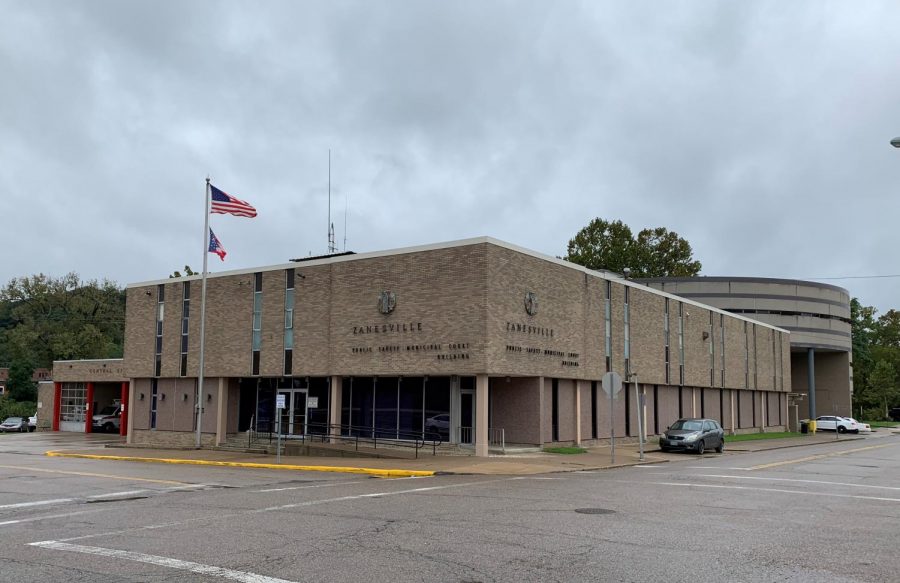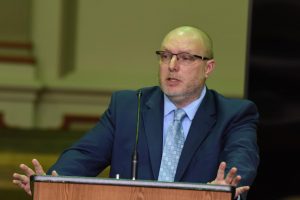Zanesville first responders approved for new equipment purchase to enhance safety
September 25, 2018
Both the Zanesville Fire Department and Police Department will soon place a new, portable radio in each on-duty first responder’s hand.
An ordinance was presented to Zanesville City Council during a meeting Monday evening for authorization in the purchasing of new MARCS radios for both departments.
Fist bumps were exchanged between police officers and firefighters in the back of the room as council passed Ordinance No. 18-106 allowing the departments to move forward in the purchasing of the new equipment.
The Multi-Agency Radio Communication System is used among first responders across the State of Ohio. With the new radios, Zanesville first responders will have the ability to communicate within their departments and with departments across the state.
Interim Fire Chief Doug Hobson said the radios his department currently uses experience certain dead spots across the city where he cannot communicate with his firefighters from the station.
“We had an apartment fire north of Zanesville, I was the shift boss that night, and I couldn’t even radio my second-in truck to let him know what the situation was,” Hobson said. “Was someone hanging out of the window? We didn’t know how we were going to handle that situation.”
While the new equipment is exciting for both departments, it comes at a price.
City officials will enter into a lease agreement with Motorola Solutions Inc. to purchase the MARCS radios over a five-year plan. The total cost of the radios is $668,298, divided between the two departments. The Fire Department is responsible for roughly $279,685, while the Police Department is responsible for roughly $388,613.
Over the five years, the Fire and Police Departments are required to pay $61,403 and $85,317 annually, respectively.
“They’re going to make the department safe, more efficient and more effective,” Public Safety Director Keane Toney said. “Communication is the key, just like in any relationship. Whether it’s a husband and wife, coworkers, communication is essential.”
Up until this point, Zanesville first responders have used old MARCS radios given to the departments by Ohio State Highway Patrol. The old radios functioned well, but Toney said with changing technology, the radios have become obsolete.
Zanesville Police Department Training Officer, Mark Brown, said his department’s radios, which already use the MARCS system, are 15 to 18 years old.
“If I have an officer break a radio, I can’t send it in to be repaired,” Brown said.
While the old radios are not up to quality communication standards for first responders, they are still functional. Thus, they will be repurposed and given to the street department and other city agencies to communicate internally between departments, Toney said.
The anticipated purchase of the new radios has been in the works for some time, but the fire department specifically experienced some hurdles with funding.
The county received $568,000 in a federal grant for all of the county fire departments, but the inner-city could not get any money through that grant, Hobson said. He added that he has also gone to the State Fire Marshal, who, unfortunately, was not able to get any funding for the city.
After some research done by radio savvy employees at both ZPD and ZFD, the departments approached Motorola personally and were able to get the same discounted rate provided to the county fire departments with the federal grant.
“The next step is for us to sell MARCS into putting a tower here in Zanesville, Ohio to eliminate any other dead spots we may have,” Hobson said. “So, today is a major win for the Zanesville Fire Department (and) the Zanesville Police Department. This is something we have wanted to move forward on.”
The new radios have a lifespan of 15 to 25 years and are designed to be both waterproof and fire resistant.
Once the agreements are finalized and signed between the city and the partnering company, the radios will arrive four to six weeks later.
“(They’re) better for the officers and better for the citizens,” Brown said.












